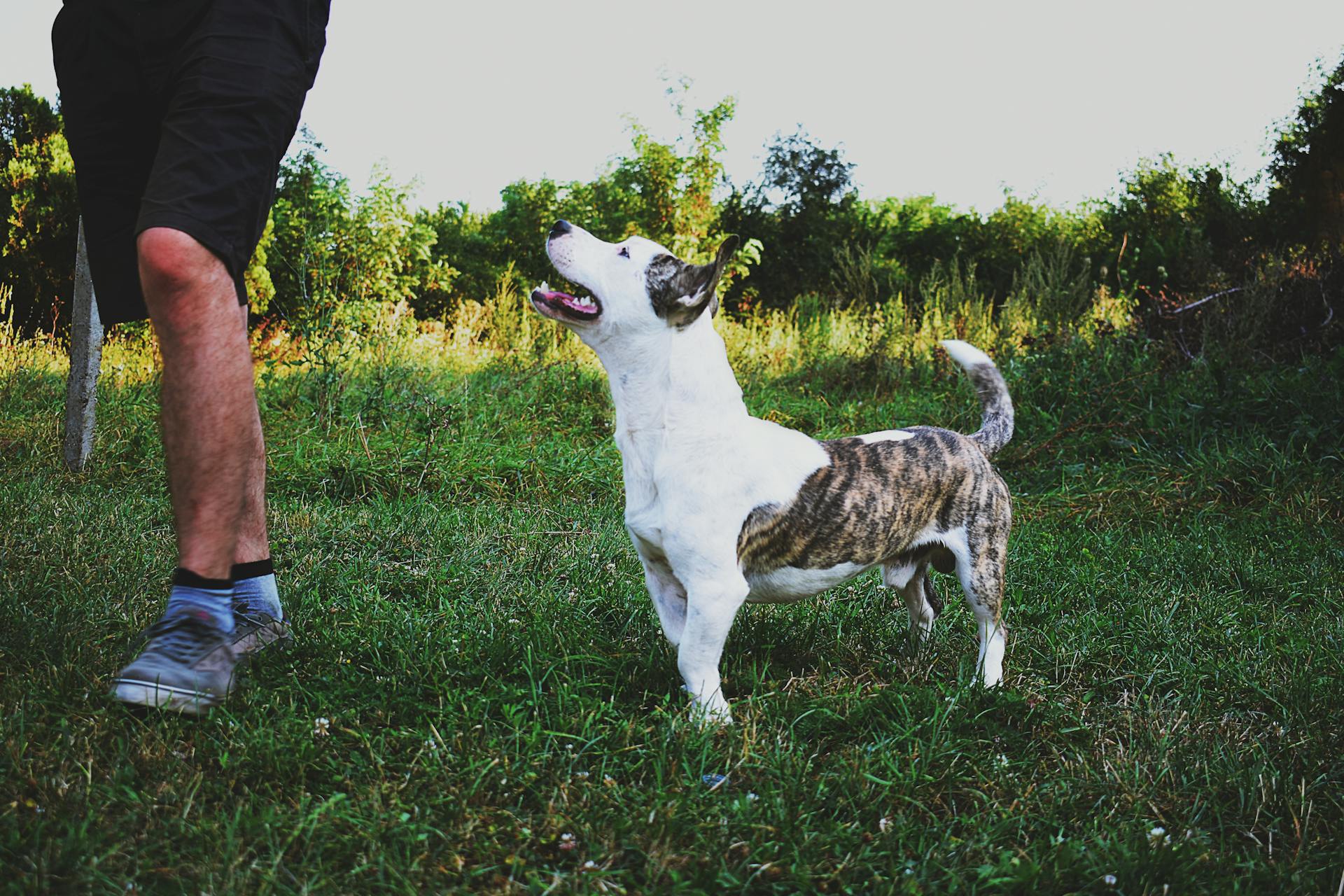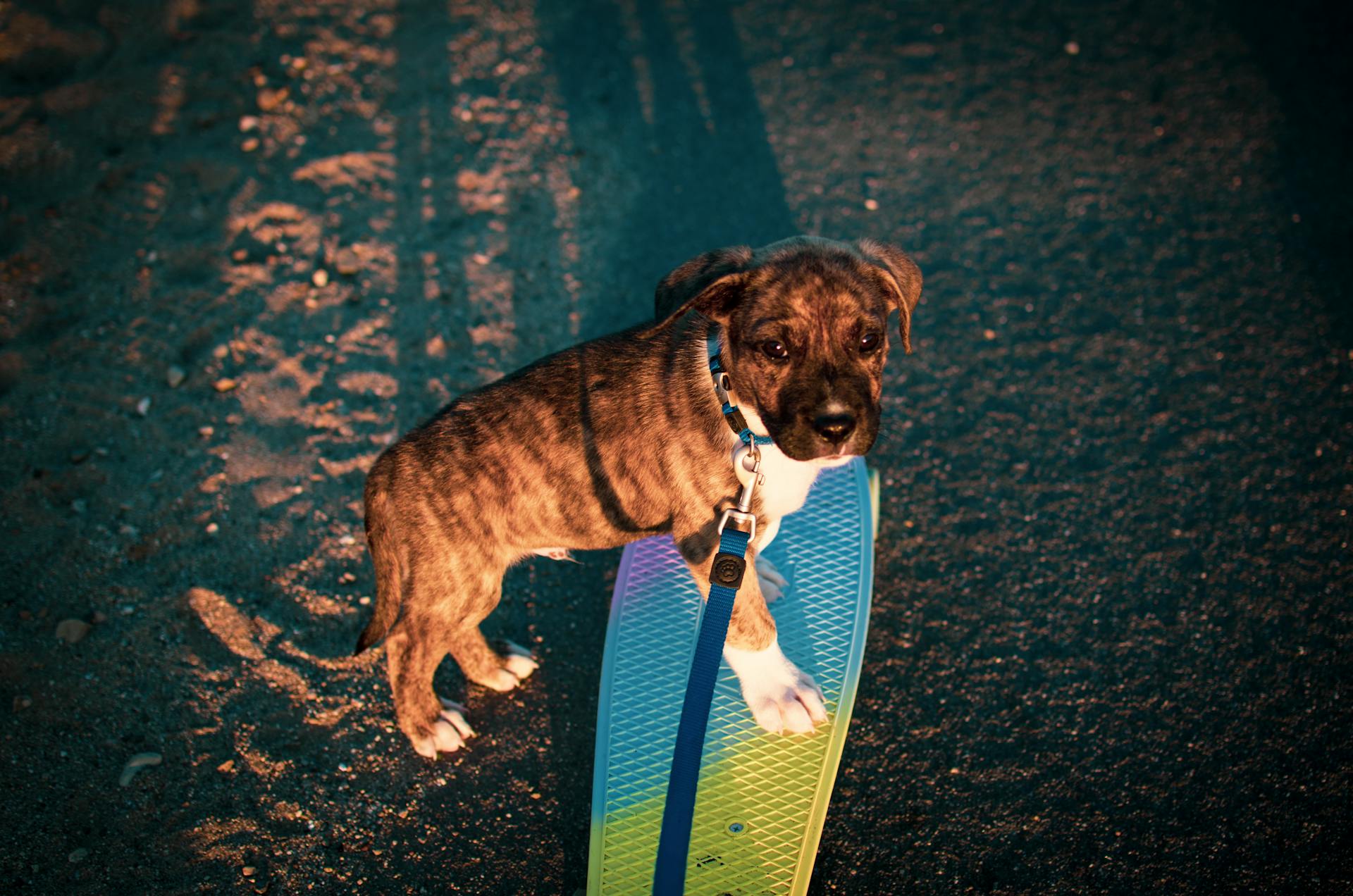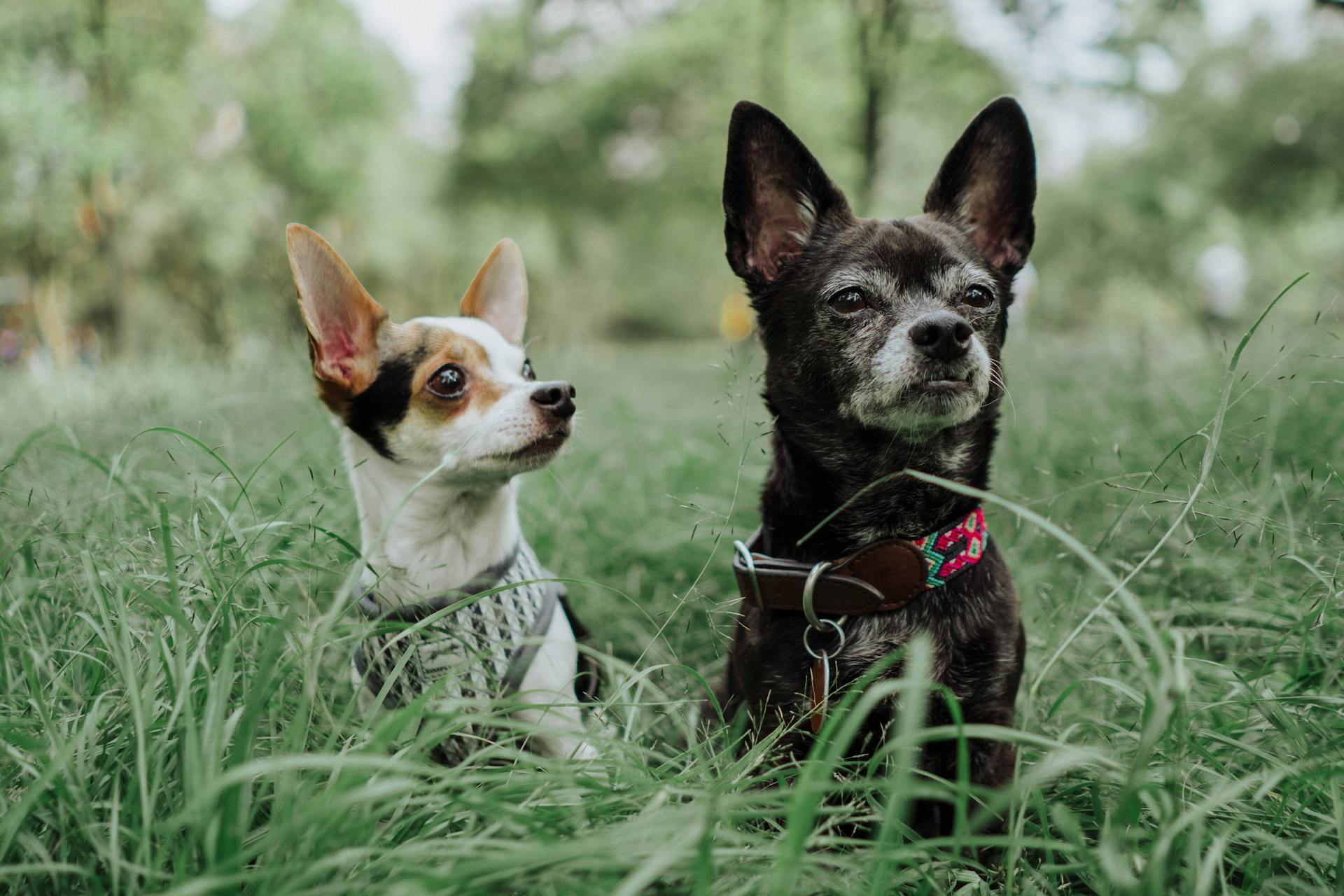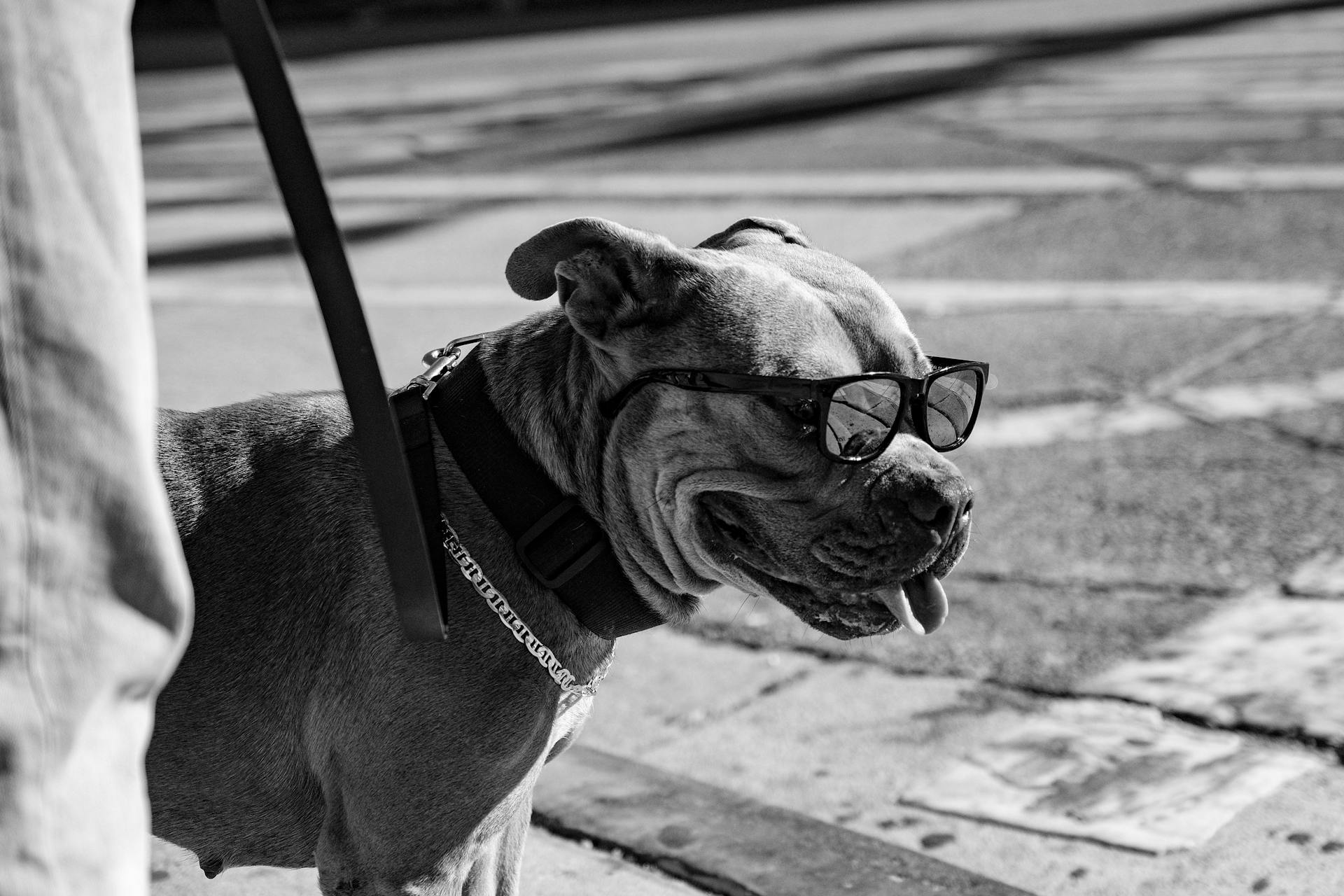
The Pit Bull Terrier Brindle is a unique and striking variation of the Pit Bull Terrier breed. They have a distinctive coat pattern featuring a mix of black, red, and fawn colors.
Their brindle pattern is the result of a specific genetic combination that affects the production of melanin, the pigment responsible for their coat color. This pattern can vary in intensity and distribution, creating a wide range of appearances within the breed.
The Pit Bull Terrier Brindle is a loving and loyal companion, known for their friendly and outgoing personalities. They are highly social dogs that thrive on interaction with their human family.
Their short, smooth coats require minimal grooming, making them a great choice for busy owners who want a low-maintenance pet.
Physical Characteristics
Pit bull terriers are a sturdy bunch, built for strength and agility. They're part of the Bull group of dog breeds, which explains their short and stocky physique.
Their wide, powerful jaws and small- to medium-sized ears set high on a broad, flat head are distinctive features. This head shape is a hallmark of the breed, and it's what makes them so recognizable.
You'll often see pit bull terriers with a whip-like tail and short, dense fur that comes in a variety of colors. The most common colors include white, gray, black, brown, brindle, tan, fawn, red, blue, and more.
Here are the most common pit bull terrier colors:
- White
- Gray
- Black
- Brown
- Brindle
- Tan
- Fawn
- Red
- Blue
They're relatively small in stature, with an average height of 17 to 21 inches from the ground to the top of their shoulders. Despite their small size, they're surprisingly heavy, with a healthy weight range of 55 to 70 pounds.
Temperament and Behavior
Pit bull terriers are known for their high energy levels, which can be mistaken for aggression if not exercised daily. They thrive on fun activities like hikes, trips to the park, and long walks, especially when spent with their loved ones.
Their natural agility makes them excellent canine climbers, so good fencing is a must for this breed. They do very well in performance events due to their high level of intelligence and willingness to work.
Pit bull terriers are eager to please and brimming with enthusiasm, making them great family dogs. They can get along well with children, earning the nickname "the nanny dog" for their tenderness around kids.
Well-trained and well-exercised pit bull terriers can be wonderful companions, but some might be more comfortable in a single-pet household. Socializing your pit bull puppy from an early age can help them get along with other dogs and cats.
Pit bull terriers have a stable temperament, which is often misunderstood due to their historical breeding for dog-aggression. However, they were not bred for human-aggression, and their breed standards emphasize a reliable temperament with people.
Despite the negative media portrayal, pit bull terriers are not inherently aggressive. In fact, they are known for their gentle and patient nature, making them a great breed for families with children.
Suggestion: Pit Bulls Are Not Dangerous
Care and Needs
Pit bull terriers are low-maintenance when it comes to grooming, requiring only a weekly brush to prevent excess shedding and matting.
They have a short, single-coated fur that makes grooming a breeze, but don't let that fool you - regular brushing is still essential to keep their coat healthy and shiny.
Regular ear cleanings are crucial, especially in humid environments, to prevent infections and keep your pittie's ears healthy.
Their nails should be trimmed on a consistent basis, about once or twice a month, to prevent foot injuries.
Daily teeth brushing is a must to prevent tooth decay, gingivitis, and gum disease, and to keep your pittie's breath fresh.
Pit bulls are strong dogs that need regular exercise to stay happy and healthy, aiming for 30 to 45 minutes of daily activity.
A daily walk and some playtime is perfect for them, and combining physical and mental stimulation is key to keeping them engaged and exercised.
On a similar theme: Healthy Bull Terrier
Grooming
The American Pit Bull Terrier is a low-maintenance dog when it comes to grooming. They have short fur and only need brushing once a week to remove dead hair and flaky skin cells.
Bath time for pitties is a once-a-month occurrence, as frequent bathing can strip their skin of natural oils. You should also brush their teeth regularly and trim their nails about once or twice a month.
Their ears require regular cleaning, ideally about twice a month, to prevent infections, but if you live in a humid environment or your pittie loves water, you may need to clean them weekly. Regular ear cleanings will help keep your pittie's ears healthy.
Daily walks and playtime are essential for your pittie, and they should get at least 30 to 45 minutes of daily activity. This can be a combination of physical and mental stimulation, such as training tricks or playing sports like lure coursing.
Readers also liked: English Bulldog Skin Rash on Belly
Living Needs

If you're considering bringing a pit bull into your life, you'll want to know that they love attention and shouldn't be left alone for hours on end. They're big softies who thrive on being at their loved one's side.
Pit bulls need regular exercise to ease their nerves when they're home alone, and a long walk or run outside can be just what they need. Exercising them also helps to keep them happy and healthy.
A large, fenced yard is ideal for a pit bull, but they can adapt to smaller spaces like apartments as long as they get proper exercise. They're happy to romp around and sunbathe in a yard, but they'll also be content in a smaller space.
Before bringing a pit bull home, check your local ordinances to see if there are any breed-specific rules or legislation that might affect you. Some cities and neighborhoods have restrictions on owning pit bulls or other breeds with fighting origins.
If you're a renter, you may have better luck finding a privately owned property that allows pit bulls than a large commercial complex. And don't be afraid to ask for advice or leads from fellow pit bull owners – they can be a great resource.
If this caught your attention, see: German Shorthaired Pointer Free to Good Home
Diet and Nutrition
Pit Bulls need about 1.5 to 2.5 cups of dry dog food per day, divided into two meals. Your veterinarian should help determine the exact amount of food your Pitie needs based on their size, age, and activity level.
Their diet will change as they age, so it's essential to work with your veterinarian to create an individual diet plan for your pet.
For every pound of body weight, Pit Bulls should drink about 0.5 to 1 oz of water per day.
For more insights, see: Shiba Inu Reaching 1 Cent
Getting a Pet
If you're thinking of getting a new pet, there are many wonderful options to consider. You can find Pit Bull Terriers and Pit Bull mixes in just about every shelter in the US.
Pit Bull Rescue Central is one such organization dedicated to finding forever homes for these dogs.
If you're interested in similar dog breeds, be sure to also check American Staffordshire Terriers, Staffordshire Bull Terriers, and Boxers.
Check this out: Dogs Breeds That Start with B
Health and Longevity
American Pit Bull Terriers are generally a hardy breed, with an average lifespan of 12 to 14 years. Their short coat can make them more prone to skin issues, such as allergies and mange.
If your pit bull is scratching excessively or has patches of red skin, it's essential to visit your veterinarian for allergy relief. Common allergy triggers include grass, pollen, and other outdoor allergens.
As your pit bull ages, keep an eye out for symptoms of hip dysplasia, kneecap dislocation, and heart conditions, as they are more prone to developing these issues. Regular wellness checks with your vet can help identify any potential problems early on.
Health
American Pit Bull Terriers are generally healthy dogs, but like all breeds, they can be prone to certain health issues. Their average lifespan is between 8-15 years, with some living up to 12-14 years with proper care.
Short coats can lead to skin issues, such as allergies and reactions to environmental factors like pollen and grass. This can cause red skin, patches, and excessive scratching.
Curious to learn more? Check out: Bull Terrier Back Then
Hip dysplasia, kneecap dislocation, and heart conditions are more common in American Pit Bull Terriers as they age. Regular check-ups with your veterinarian are crucial to catch these issues early.
Skin problems like mange and skin allergies are also common in this breed due to their short coat. Mange can be treated with ivermectin injections or oral medications.
Allergies require lifelong management, and your veterinarian may recommend dietary adjustments or medication like Benadryl for dogs. Regular veterinary care can help prevent and manage these issues.
Demodex mange is a common issue in American Pit Bull Terriers, especially in puppies, and can be diagnosed with a simple skin scraping test. It's essential to vaccinate your puppy against parvovirus to prevent this condition.
With proper care and regular veterinary check-ups, American Pit Bull Terriers can live long, healthy lives.
You might like: Pitbull Dog Skin Rash
Average Lifespan
Living a long and healthy life is within reach for your Pit Bull. Most American Pit Bulls live for about 12 years.
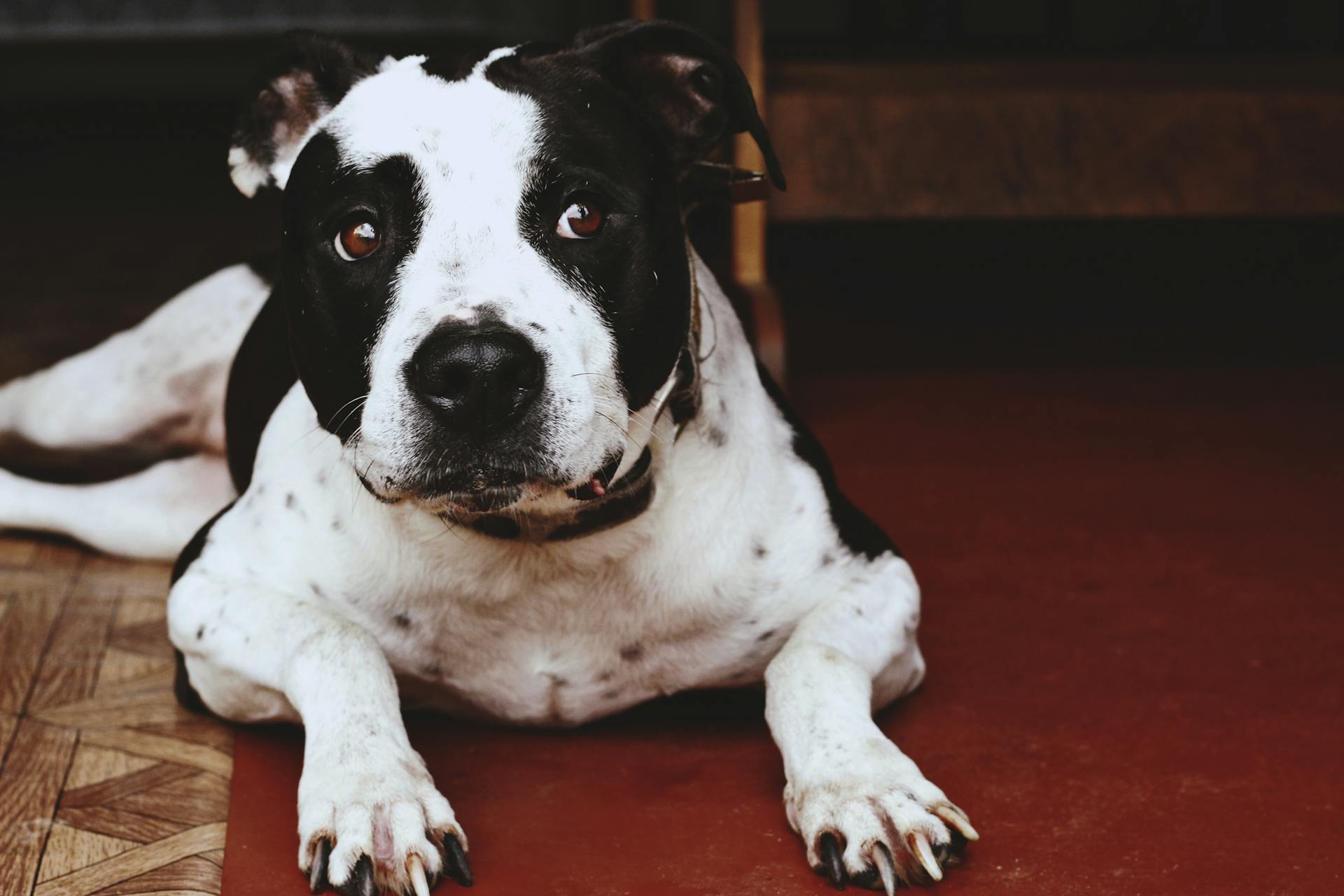
Regular wellness checks with your vet can make a big difference in your Pit Bull's lifespan. Taking them to the vet every six to twelve months can help identify potential health issues early on.
Keeping your Pit Bull at a healthy weight is crucial for their longevity. This can play a big part in helping them achieve a long, fulfilling life.
Ownership and Legislation
Pit bull terrier brindle owners face various restrictions and laws in different countries and regions. The United Kingdom has a strict law against owning, selling, or breeding pit bull terriers.
Breed-specific legislation is in place in many countries, including the United Kingdom, Brazil, and Australia. These laws range from outright bans to restrictions on import and ownership conditions.
Some cities in the United States and the province of Ontario, Canada, have banned ownership of American Pit Bull Terriers. As of September 2023, at least 120 repeals of breed-specific legislation have occurred since 2018.
The effectiveness of breed-specific legislation is debated, with some arguing that it has reduced dog bites involving pit bull types, while others point out that other breeds may be contributing to the rise in dog bites.
American Overview
The American Pit Bull Terrier, also known as the American Pit Bull, is a beloved breed that's often misunderstood. They have a lifespan of 8 to 15 years, making them a long-term companion for many families.
Their physical characteristics are quite distinctive, with a height range of 17 to 21 inches and a weight range of 35 to 70 pounds. They have a short coat that requires minimal grooming, which is a plus for busy owners.
One of the most important things to consider when owning an American Pit Bull Terrier is their exercise needs. They require high levels of physical activity to stay happy and healthy, making them a great choice for families who enjoy outdoor activities.
Here are some key characteristics to keep in mind when considering an American Pit Bull Terrier:
Their temperament is friendly, playful, and willful, which can make them a great match for families with children. However, they do require consistent training and socialization to ensure they grow into well-behaved adults.
Breed-Specific Legislation
Breed-specific legislation has been implemented in various countries and regions, affecting the ownership of pit bull-type dogs. The United Kingdom, Brazil, Australia, and several other countries have enacted laws restricting or banning the ownership of American Pit Bull Terriers and similar breeds.
Some countries have outright banned the breed, while others have implemented restrictions on import and ownership. In the United Kingdom, it's against the law to own, sell, abandon, give away, or breed a Pit Bull Terrier.
Certain cities in the United States and the province of Ontario, Canada, have banned ownership of American Pit Bull Terriers. As of September 2023, at least 120 repeals of breed-specific legislation have occurred since 2018.
Interestingly, a province-wide ban on "pit bulls" in Ontario, Canada, led to a significant decrease in dog bites involving pit bull types. However, other dog breeds contributed to the rise in reported dog bites in Toronto.
A notable example of breed-specific legislation is the state of New South Wales in Australia, which places restrictions on the breed, including mandatory sterilization.
Here's a list of some countries and regions that have implemented breed-specific legislation on pit bull-type dogs:
- United Kingdom
- Brazil
- Australia (New South Wales)
- Ecuador
- Malaysia
- New Zealand
- Puerto Rico
- Singapore
- Venezuela
- Trinidad and Tobago
- Denmark
- Israel
- France
- Germany
- Norway
- Poland
- Portugal
- Romania
- Spain
- Switzerland
- Turkey
Keep in mind that breed-specific legislation is a complex and debated topic, and its effectiveness is still being researched and discussed.
Breed Information
The American Pit Bull Terrier originated from a long line of Terrier and Bull breeds created in England, Ireland, and Scotland during the early 19th century. They were initially bred to kill vermin, hunt small game, and participate in dogfighting.
Bulldogs were also bred for pit fighting with other dogs, as well as bull- and bear-baiting. The resulting creation was the 'ideal competitor' in these horrifically bloody sports: a dog that refused to give up, no matter how excruciating the pain, with an unabashed love for humans who put them in the pit, then pulled them from the same.
The breed's talent for herding livestock, warding off vermin, and devotedly guarding the home did not go unnoticed by American farmers.
Breed History
The American Pit Bull Terrier has a rich and complex history that spans over a century. Originally bred in England, Ireland, and Scotland in the early 19th century, Terriers and Bulldogs were cross-bred to create a strong and muscular dog.
These early "bull and terrier" mixes were bred for dogfighting and other bloodsports, but they also proved to be talented farmhands, able to herd livestock and ward off vermin. After dogfighting was banned in Europe, many of these dogs were brought to the US, where they evolved into the American Pit Bull Terrier.
The breed's popularity grew as American farmers recognized their value as working dogs, and they eventually gained recognition from the United Kennel Club (UKC) in 1898. However, the American Kennel Club (AKC) refused to recognize the breed due to its bloody lineage.
In the early 20th century, pit bulls were used as catch dogs for semi-wild cattle and hogs, and as family companions. Despite their reputation, many pit bulls proved to be loyal and loving companions, and they remain a popular breed today.
Discover more: American Kennel Club Lancashire Heeler
Bloodlines
The American Pit Bull Terrier has several bloodlines, many of which originated in "professional" dog fighting throughout the 20th century. These bloodlines were developed for the conformation shows of the United Kennel Club in the 1980s.
You might like: American Bully Bloodlines
The Castillo bloodline is a notable example, founded by Tekla Castillo in the early 1980s. It features a mix of different breeding lines, resulting in dogs with desirable traits such as strength, intelligence, and temperament.
The Castillo bloodline's foundation includes dogs like "PR" Nelson's Hazard Joe, born from breeding between Camarano's Buster Jo and Coonie's Bonnie. This bloodline has expanded over time due to the collective efforts of multiple breeders who contributed to its development.
The history and ancestry of the APBT bloodlines can provide context and insight into the breed's development. However, it's essential to prioritize responsible breeding practices and the well-being of individual dogs.
Similar Breeds and Mixes
If you're looking for breeds similar to the pit bull terrier brindle, you might want to consider the American Staffordshire terrier, which is often referred to as the "nanny dog" due to its gentle nature.
The American Staffordshire terrier is similar in size and build to the pit bull terrier brindle, with males weighing up to 60 pounds and standing between 17 and 20 inches tall.
A different take: Dogs Similar to Border Collies
The Bull Terrier is another breed that shares some physical characteristics with the pit bull terrier brindle, such as its muscular build and broad chest.
The Bull Terrier is known for its unique egg-shaped head and short, easy-to-maintain coat, which requires minimal grooming.
The Staffordshire Bull Terrier is a smaller version of the American Staffordshire terrier, weighing up to 38 pounds and standing between 14 and 16 inches tall.
This breed is known for its affectionate and playful personality, making it a great companion for families with children.
The American Pitbull Terrier is a variation of the American Staffordshire terrier, with a similar build and temperament, but often with a shorter, more compact body.
The American Pitbull Terrier is highly intelligent and trainable, making it a popular choice for first-time dog owners.
The Blue Heeler Pitbull mix is a popular crossbreed that combines the loyalty and intelligence of the Blue Heeler with the athleticism and playfulness of the pit bull terrier brindle.
This mix is often used as a working dog, due to its high energy levels and strong work ethic.
The Pitbull Beagle mix is another crossbreed that combines the friendly and outgoing personality of the Beagle with the athleticism and loyalty of the pit bull terrier brindle.
This mix is often used as a family dog, due to its gentle and affectionate nature.
Take a look at this: Ten Most Popular Dogs Breeds
Frequently Asked Questions
Are brindle Pit Bulls rare?
Brindle Pit Bulls are actually more common than other standard colors, but finding two identical ones can be challenging.
Are brindle Pit Bulls good dogs?
Brindle Pit Bulls can make fantastic pets and loyal companions when raised in a loving home. They are known for their fun-loving nature and can thrive with proper care and attention.
How much is a brindle Pitbull worth?
A Blue Brindle Pitbull's price typically ranges from $1,000 to $3,000 from reputable breeders. If you're interested in bringing one home, be prepared for a significant investment.
Sources
- https://www.dailypaws.com/dogs-puppies/dog-breeds/american-pit-bull-terrier
- https://en.wikipedia.org/wiki/American_Pit_Bull_Terrier
- https://www.shawpitbullrescue.com/can-you-find-the-pit-bull/what-is-a-pit-bull/
- https://www.pawlicy.com/blog/pit-bull-terrier-dog-breed/
- https://www.thepuppyacademy.com/blog/2022/1/10/a-guide-to-puppy-breeds-american-pit-bull-terrier
Featured Images: pexels.com
